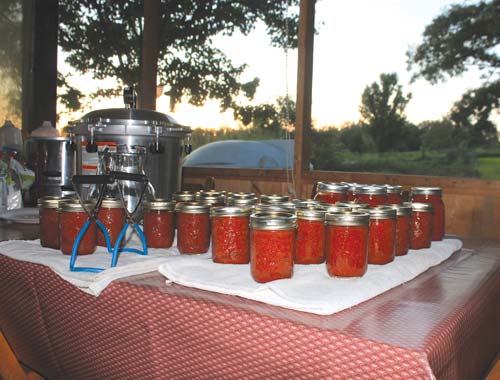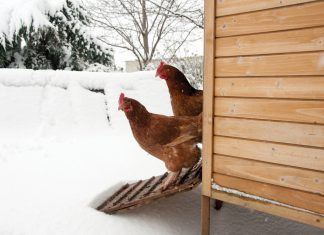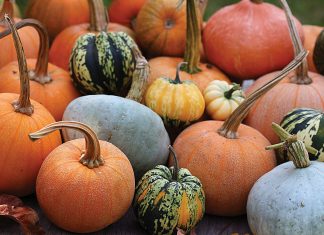| Issue #148 • July/August, 2014 |
Tomatoes are the backbone for the homestead garden and pantry. These succulent fruits are great on quick sandwiches, mixed in a pasta salad, or (my personal favorite) sliced with a little sugar sprinkled on top. Tomatoes only store for a short time out of the garden, and the plants bear tons more than can be eaten. So as self-reliant homesteaders what do we do? We can them, of course!
Tomatoes are easily preserved to use in the off season. Canning halved tomatoes and tomato juice is just the tip of the iceberg. You can efficiently preserve your very own tomato products while saving money on your grocery bill and enjoying that old-fashioned, good tastin’ food.

It’s very satisfying to have plenty of tomato products for winter use.
Great savings
You can reap many positive benefits by making your own tomato products. Not only will a lot of money be saved, but your homemade foods will taste so much better. You’ll know how the crop was raised and how it was processed. In today’s industrial food market we never really know what is in our foods, unless we grow them ourselves.
We recently went to the local grocery store to gather retail prices of our core pantry tomato products. We gathered the prices for a leading brand (moderately priced, and what we would choose), the store brand, and a value brand. Some of these products were not available in the value brand or store brand.
It is very expensive to stock a pantry by purchasing the products at the grocery store. If you want enough canned tomatoes to use twice a week for a year and enough tomato sauce to use once a week, you will need 104 quarts of tomatoes and 52 pints of tomato sauce. On top of that, we all know that it is so convenient to have pizza sauce, spaghetti sauce, and tomato soup already made and waiting to be used on the pantry shelves. Of course, no pantry is complete without a good supply of salsa.
The yearly costs for stocking your pantry with the store-bought products is substantially higher than if the products were home grown and preserved. The estimated cost for stocking your pantry with leading brand products according to my quantities would cost approximately $626.78. That’s a big chunk of change. I have estimated my homegrown, homemade products to cost my family approximately $78.69; this is the estimated cost of last year’s tomato seeds, fertilizer, sowing materials, spices, and canning supplies. It only makes sense to stock your pantry with home-canned items.

Basic supplies
There are a few supplies you will need to preserve these foods. You will need lots and lots of quality tomatoes. For the homestead pantry, you will need paste tomatoes or old-fashioned canning tomatoes. These types of tomatoes cook up the best as they have drier flesh than many slicing tomatoes. They are as juicy and usually have fewer seeds. My favorite variety of tomato is the Amish Paste. It grows to a large size, and is perfect for sauce and salsas not to mention, the vines bear prolifically. Other good tomatoes are the Rutgers tomato or the San Marzano. You can still use “regular” garden tomatoes, but paste and canning types will have better results.
You will need a good supply of Mason jars, lids, and rings. Your jar size will depend on the product you intend to make. For canned tomatoes, I prefer a variety of pints and quarts because different sizes are needed for different dishes. For tomato sauce, I prefer pints. For spaghetti sauce and tomato soup, I find quarts to be more efficient. It all depends on your recipes and eating habits. You will use your homemade products a lot more and waste a lot less if they are in handy sizes.
It is also essential to have your basic canning supplies: a jar lifter, lid magnet, and funnel. You will need a large, thick stock pot, a kettle to simmer lids, a good ladle, and assorted dishes. I use both a water bath and pressure canner for my tomato products. Water bath is the recommended way to process high-acid tomato products; I use it to can tomatoes, tomato juice, and salsa. However, I use my large pressure canner to process big batches of cooked down products like spaghetti sauce and pizza sauce.
A well-stocked spice cabinet will come in handy. Many tomato products require garlic powder, oregano, or basil. Most of those can be readily and easily grown in the home garden, or obtained at your local grocery store. For my recipes the ingredients will be the dehydrated form.
When making your own tomato products, you will find a colander or a food mill to be very effective. This will remove the seeds and the peels, while mashing the pulp and straining the juice. The hard-core homesteader who stocks all their own tomato products will need one of these devices to save time.

When cooking down tomato sauce, be sure to stir often to prevent scorching.
Back to the basics
There are a few basic processes that you will use on every type of tomato product that you make. Choose perfectly ripe fruits, remove all blemishes and bad spots, and wash gently in warm water. It doesn’t hurt to smell your sliced tomatoes as you go to ensure there isn’t any souring.
No matter what you are making, please be sure to keep everything hot. Place hot food into hot jars, and then place into a hot canner. This is essential for thorough processing, and will safeguard against broken jars.
Halved tomatoes
tomatoes
water
salt
lemon juice
Begin this process by peeling, coring, and removing the seeds from your fruit. To peel tomatoes, dip them in boiling water for around a minute or until the skin pops. Remove and immediately dip the tomatoes in cold water. After they are cool, you can begin pulling off the skins. Halve the tomato and remove the core. Be sure to remove any bad spots or green spots as you core and peel your tomatoes. Place all your tomatoes in a large, thick pot and add two cups of water. Gently cook the tomatoes until tender. During this time, the tomatoes should release some natural juices. When the tomatoes are heated through, place the hot food into hot jars and add a tablespoon of lemon juice to pints or two to quarts and a teaspoon of salt, if you wish. Place the jars into a hot boiling water bath canner and process quarts for 45 minutes and pints for 40 minutes. After processing is through, remove your jars and place on a thick padded surface. Leave the jars overnight to cool and allow plenty of time to seal.

Basic tomato sauce
tomatoes
water
salt
lemon juice
Using fresh and ripened red tomatoes, begin this process by quartering your fruit. Place all your tomatoes in a large thick pot and gently cook until tender. When the tomatoes are tender, run them through a colander or a food mill. Return the pulp and juice to the large pot. Cook this mixture until the desired thickness is reached. This may take a couple of hours. Alternatively, you can cook this mixture down in the oven overnight in a roasting pan. If you need to hurry the process along, you can add a few cans of tomato paste to thicken the mixture. Once the sauce reaches the desired thickness, place hot sauce into hot jars (along with salt and a tablespoon of lemon juice for pints or two tablespoons for quarts), and process the sauce in a boiling water bath canner for 35 minutes (pints) or 40 minutes (quarts). If you are processing the jars of sauce in a pressure canner, process your pints and quarts for 15 minutes at 10 pounds pressure. After processing is through, remove your jars and place on a thick padded surface. Leave the jars overnight to cool and allow plenty of time to seal.
Tomato juice
tomatoes
water
salt
lemon juice
Using fresh and ripened red tomatoes, begin this process by quartering your fruit. You can use regular garden tomatoes for this. Place your tomatoes in a large, thick pot and gently cook until tender. When the tomatoes are tender, run them through a colander or food mill. After the tomatoes have been processed, return the pulp and juice to the large pot. Cook this mixture until hot through. Ladle hot juice into hot jars, and put a tablespoon of lemon juice in pints and two tablespoons in quarts. Process in a water bath canner 35 minutes for pints or 40 minutes for quarts of tomato juice. After processing is through, remove your jars and place on a thick padded surface. Leave the jars overnight to cool and allow plenty of time to seal.
These are the most basic tomato recipes and are considered staples. The next recipes I want to share with you are more specialized and have been in our family for many years.

A batch of spaghetti sauce is starting to cook. It will take a few hours.
Betty’s salsa
My grandmother has made this special family recipe for many years. Our closest family and friends have fond memories of eating this great garden treat.
4 quarts tomatoes, peeled and chopped
4 cups onions, chopped
4 cups green bell peppers, chopped
6 Tbsp. canning salt
2 cups sugar
8 cloves garlic, chopped (2 heaping Tbsp. of canned, minced garlic can be substituted)
8 jalapeños, chopped
1½ cups white vinegar
In a large thick pot, combine all ingredients (except vinegar) and simmer for one and a half hours. After this time has elapsed, add the vinegar and bring the mixture to a boil. Ladle hot salsa into hot jars and process quarts and pints for 35 minutes in a boiling water bath canner. After processing is finished, remove your jars and place on a thick padded surface. Leave the jars overnight to cool and allow plenty of time to seal.
Spaghetti sauce
12 quarts tomatoes, peeled, seeded, and chopped
3 Tbsp. garlic powder
3 Tbsp. parsley flakes
3 Tbsp. crushed oregano
1 cup sugar
½ cup salt
1 pint vegetable oil
4 pints tomato paste
4 large bell peppers, chopped
6 lbs. onions, chopped
Combine all ingredients into a large stock pot and bring to a full boil. Lessen heat and cook until desired thickness is reached. Ladle hot spaghetti sauce into hot quart jars and pressure can for 25 minutes at ten pounds pressure. After processing is finished, remove your jars and place on a thick padded surface. Leave the jars overnight to cool and allow plenty of time to seal. This recipe yields about 12 quarts of sauce.

A couple pints of salsa made fresh from the garden.
Pizza sauce
4 cups thick tomato sauce
2 Tbsp. crushed oregano
2 tsp. paprika
2 tsp. garlic powder
½ tsp. salt
½ tsp. black pepper
1 tsp. parsley flakes
3 Tbsp. molasses
In a medium pot, mix all ingredients thoroughly. Place on low heat and heat through. When the sauce is hot, sample to make sure it is to your liking. When the sauce reaches your qualifications, ladle hot pizza sauce into hot jars, and process in a pressure canner for 20 minutes at five pounds pressure. After processing is finished, remove your jars and place on a thick padded surface. Leave the jars overnight to cool and allow plenty of time to seal.
If you have an abundance of tomatoes this year, get busy and can a good supply of tomatoes, tomato sauce, tomato juice, salsa, tomato soup, spaghetti sauce, and pizza sauce. Home-canned tomato products have an important place in the homestead pantry, and can save you a lot of money at the grocery store.















Wow! I had no idea what store-bought canned goods cost nowadays!
You can also find recipes online for canning pickled cherry tomatoes. You must prick each with a sterile needle. I like to add dill. These are very good on winter salads or a relish tray. If you handle them gently, they will keep their shape. I like to use yellow Gold Nugget Tomatoes.